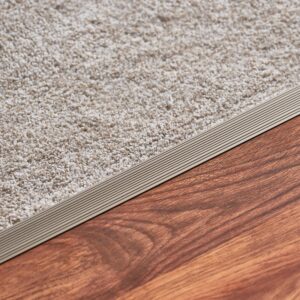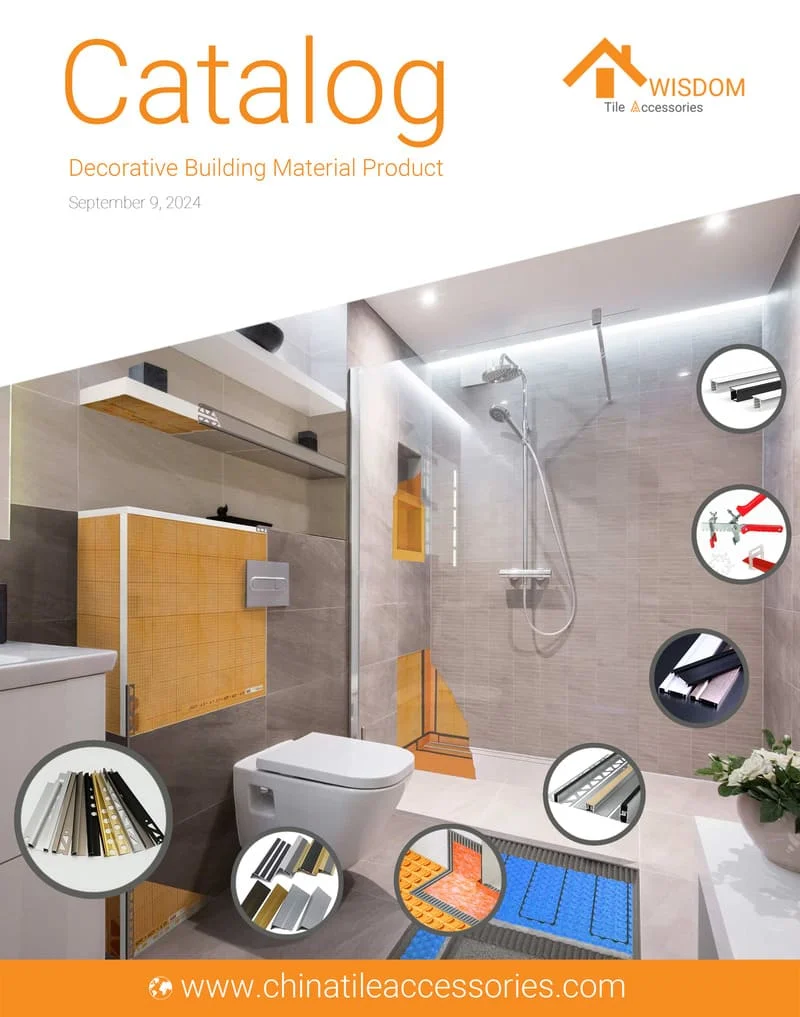Transition strips for tile floors are an important part of tile floor installations. They improve the aesthetics of spaces and enhance the safety, durability, and maintenance of tile floors. They come in a variety of materials, colors, and designs, allowing smooth transitions between different types of flooring materials. Learn how using tile transition strips can prevent accidental trips, prevent tile edges from chipping or cracking, and make cleaning and maintaining tile floors easier.

Reason 1: Aesthetic Appeal
Aesthetics are an important consideration when designing a tiled space. Transition strips can be used to enhance the overall look of a tiled space. They can help create a smooth and polished look and make transitions between different floor types more seamless. This is especially important when using different types of tiles in the same space, such as ceramic tiles and natural stone tiles.
Types of tile transitions
There are several different types of transition strips available for tile. Each type has its own advantages and disadvantages, so it is important to choose the correct type based on the specific needs of the project. Here's an overview of the different types of transitions and where they work best:
T-Shaped Transition: This type of transition is the most common and versatile one. It is shaped like a T and is suitable for two different types of floors. T-shaped transition strips are available in a variety of materials, including metal, wood, and plastic, and can be used on tile, carpet, or hardwood floors. They are easy to install and provide a smooth transition between floor types.
Reducer Transitions: Reducer transitions are used to transition from a higher floor surface to a lower floor surface. They can be used as a transition between tile and carpet, tile and hardwood floors, or tile and vinyl floors. This type of transition strip is also available in a variety of materials, such as metal, wood, or vinyl, and can be installed using adhesive or screws.
Threshold Transition: This type of transition is used in doorways or areas where two types of flooring meet. It provides a smooth transition between floors of different heights and styles and can be used on tile, carpet, or hardwood floors. Sill transition strips are usually made of wood or metal and come in different widths and lengths.
Corner Transitions: Corner transitions are used to create a transition between two tile surfaces that meet at a corner. They are usually made of metal or plastic and are easy to install. Corner transitions are especially useful in bathrooms and kitchens, where tile surfaces often meet at corners.
Overall, the right type of transition strip can enhance the look of a tiled space by providing a smooth and polished transition between different types of flooring. It is important to choose the right type of transition zone based on the specific needs of the project, as each type has its own advantages and disadvantages.
Reason 2: Improve security
When it comes to floors, safety is always a top priority. This is especially true when transitioning between different floor surfaces, where differences in height or texture can create tripping hazards. This is where transition strips of tile can make a big difference.
Explain how transition strips for tile floors reduce trip hazards between different floor surfaces:
Tile transitions create a smooth, level surface between different flooring materials, reducing the risk of tripping or falling. For example, when transitioning from tile to carpet, transition strips can be used to create a seamless and safe transition between the two surfaces.
Statistics or studies supporting the safety benefits of transition belts:
According to the Centers for Disease Control and Prevention (CDC), falls are the leading cause of injury-related death among older adults in the United States. In fact, one in four Americans age 65 and older falls each year. While transition straps may seem like a small detail, they can make all the difference in preventing falls and injuries.
Best Practices for Installing Transition strips for tile floors
Installing tile transitions is a simple process that most DIYers or professional installers can do. However, there are some best practices to keep in mind to ensure a safe and secure installation.
A step-by-step guide on how to install a transition strips for tile floors
Measure the length of the transition area and cut the transition strip to size using a saw or scissors.
Place the transition strip over the gap between the two floor surfaces and make sure it is level.
Screw or nail the transition strip to the subfloor with suitable fasteners.
Apply a layer of construction adhesive along the bottom of the transition strip to hold it in place.
Smooth off excess adhesive with a putty knife and allow it to dry for at least 24 hours before walking on it.
Common mistakes to avoid during installation:
A common mistake when installing transitions is not leaving enough room for stretching. Over time, this can cause the strip to bend or warp. Another mistake is not using the correct type of fasteners for the subfloor material. This can cause the transition strip to come loose or come off the subfloor.
To avoid these problems, be sure to follow the manufacturer's instructions and use tools and materials appropriate for the job. Also, if you're not comfortable with a DIY installation, it's best to hire a professional installer.
By following these best practices, you can ensure the safe and secure installation of tile transitions and enjoy the added safety and convenience they provide.
Reason 3: Increased Durability
Durability is a major consideration when installing tile. The last thing you want is a beautiful tile floor that starts to chip or crack after a few months of use. Fortunately, transition strips can help prevent this from happening by protecting the edges of your tiles.
Transitions can be made from a variety of materials, including wood, metal, plastic, and rubber. Each material has its own unique advantages in terms of durability, cost, and aesthetic appeal. Wood transitions, for example, are durable and can give a room a warm and inviting feel, while metal transitions have a more modern and industrial feel.


Here are a few factors to consider when choosing the right transition for your tile:
Materials: As mentioned earlier, there are different materials to choose from, so consider which will best suit your specific needs and budget.
Width: Transition strips come in different widths, so consider the width of the tile and adjacent floor when choosing the right size.
Height: The height of the tile and the height of the adjacent floor should also be taken into consideration. You want to ensure that the transition strip provides a smooth and seamless transition between the two surfaces.
Color: The color of the transition zone should complement the tile and floor. Some transition strips come in a variety of colors, while others are designed to be painted to match your existing decor.
At Awisdom, we offer a wide range of high-quality tile transitions that are as durable as they are beautiful. Made from high-quality materials, our transition bands are available in a variety of colors and sizes to suit your needs. Whether you're looking for wood, metal, plastic, or rubber transition strips, we've got you covered.
How to choose the right transition strips for tile floors
When choosing a transition strip for your tile, there are several factors to consider. These factors include the type of tile you use, the height difference between floor surfaces, the width of transition areas, and the overall design aesthetic of the space.
Here are some tips for choosing the right transition:
Consider the type of tile. Different types of tile require different types of transitions. For example, if you are using ceramic tile, a metal transition strip may be the best choice, while a vinyl transition strip may be better for vinyl tile installations.
Measure height differences: If the height difference between two floor surfaces is small, a simple T-bar may suffice. However, if there is a large difference in elevation, a slope transition may be required.
Determine the width of the transition zone: The width of the transition zone will also affect the type of transition zone you need. If the transition area is wide, a wider transition band may be required to provide proper support and stability.
Consider Design Aesthetics: Finally, consider the overall design aesthetic of the space. You want to choose a transition that complements the tile design and the overall style of the room.
At Awisdom, we offer a wide range of tile transition strips designed to meet the needs of any project. Our products are made of high-quality materials to ensure durability. We also offer a variety of styles and finishes to complement any design aesthetic. Whether you are looking for a simple T-shape transition or a more elaborate ramp transition, we have the perfect product for your project.
Overall, choosing the right transition strip for your tile is critical to ensuring a seamless and functional flooring installation. By considering the above factors and choosing a high-quality product from a trusted manufacturer like Awisdom, you can be sure that your tile installation will be as safe as it is beautiful.
Reason 4: Easier to maintain
Transition strips not only enhance the appearance and durability of tile floors but also make cleaning and maintenance a breeze.
Explain how transition strips make cleaning and maintaining tile floors easier. Transition strips act as a barrier between different types of floor surfaces, preventing debris, dirt, and moisture from getting between the tiles. By preventing this buildup, you can avoid unsightly stains, mildew, and discoloration. Transition strips can also help prevent chipping or cracking at tile edges, which can make cleaning and maintenance more difficult.
Discuss how certain transition strips prevent dust and debris from getting between tiles. T-shaped transition strips, for example, are particularly effective at keeping dust and debris from getting between tiles. That's because the T-shape creates a raised barrier that keeps dirt and debris from getting into the gaps between the tiles.
How to clean and maintain tile floors
Keeping your tile floors looking their best requires regular cleaning and maintenance. Here are some tips and tricks:
Tips and tricks on how to keep your tile floors looking their best: First, regular sweeping and mopping can go a long way toward preventing dirt and debris from accumulating on tile floors. For stubborn stains or grime, use a mild cleaning solution that is safe for tile. Avoid using abrasive cleaners or tools that can scratch or damage the tile surface.
Recommended cleaning products and tools: Some recommended cleaning products and tools include pH-neutral tile cleaners, microfiber mops, and soft-bristle brushes. When choosing a cleaning product, be sure to read labels carefully and choose products that are safe to use on your specific type of tile.
Remember that regular cleaning and maintenance will help extend the life of your tile floors, so be sure to take the time to take care of them properly.
Reason 5: Cost-effective Solution
There are a variety of options when it comes to finishing the edge of your tile floor. However, using a transition zone can be a more cost-effective solution than other finishing methods. Transition strips are relatively inexpensive and can add a professional look to any tiled space.
Transitions are often more affordable than other finish options like fillet tile or custom trim. They are available in a variety of materials and styles, meaning there is a solution for every budget.
DIY vs. professional installation of tile transitions
When it comes to installing tile transitions, you have the option of installing them yourself or hiring a professional. While DIY installation may seem like a cost-effective solution, it may not always be the best option.
The advantages of DIY installation include cost savings and the ability to customize the installation to your specific needs. However, DIY installation also has potential downsides, including the risk of making mistakes, which could lead to more expenses down the road.
Hiring a professional to install transition strips ensures that the job is done correctly and efficiently. Professionals have the experience and expertise to meet any challenges that may arise during installation. Plus, hiring a professional can save you time and stress.
At Awisdom, we offer a range of transition zone products and installation services. Our team of experts can help you choose the right transition strip for your tile and ensure it is installed correctly. Whether you decide to go DIY or have it professionally installed, we are here to support you.
Conclusion
Tile transitions offer many advantages, including improved aesthetic appeal, safety, durability, easier maintenance, and cost-effectiveness. We encourage readers to consider incorporating transition strips into their own tile spaces to enhance the overall appearance, safety, and longevity of the floor. At Awisdom, we offer a wide range of high-quality transition strips and installation services to suit your needs. Don't hesitate to contact us for more information and start enjoying the benefits of transition strips today.


